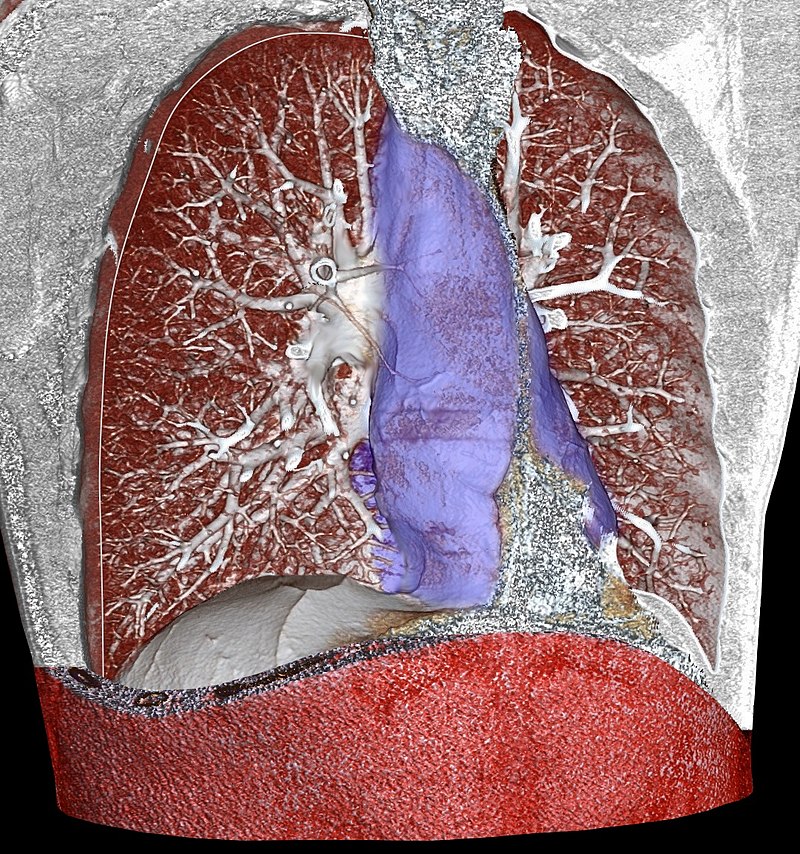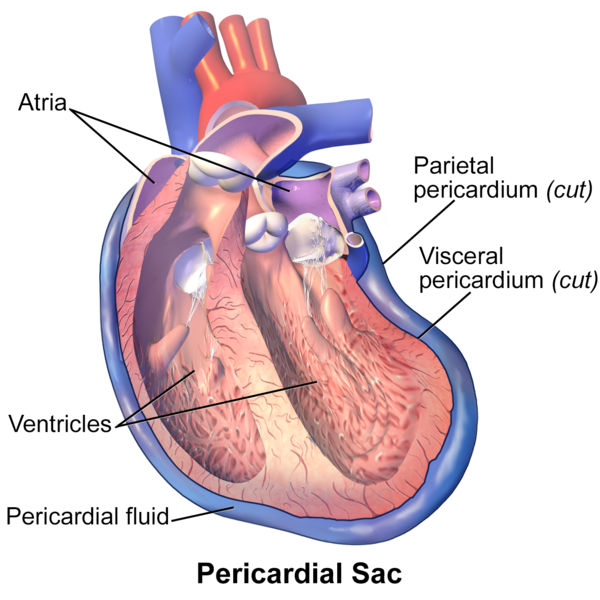The key difference between mediastinum and pericardial cavity is that mediastinum is the central compartment of the thoracic cavity located between the two pleural sacs, while the pericardial cavity is the space formed between the two layers of the serous pericardium of the heart.
The thoracic cavity is the hollow space surrounded by the rib cage and diaphragm. It contains three compartments: two pleural cavities and a mediastinum. The mediastinum is divided into superior mediastinum and inferior mediastinum. The latter is further subdivided into anterior, middle, and posterior. The middle mediastinum contains the heart covered by the pericardium. The serous pericardium contains the pericardium cavity, which facilitates the free movement of the heart. Therefore, the mediastinum and pericardial cavity are two compartments that protecting organs in the human body.
CONTENTS
1. Overview and Key Difference
2. What is Mediastinum
3. What is Pericardial Cavity
4. Similarities – Mediastinum and Pericardial Cavity
5. Mediastinum vs Pericardial Cavity in Tabular Form
6. Summary – Mediastinum vs Pericardial Cavity
The mediastinum is the central compartment of the thoracic cavity that is surrounded by loose connective tissues. It is also known as the mediastinal cavity. It contains the heart and its vessels, oesophagus, trachea, thoracic ducts, phrenic and vagus nerves, thymes, and lymph nodes. It acts as a conduit for structures that are travelling across the thorax on their way to the abdomen. Superior and inferior mediastinum are two parts. The superior mediastinum extends upwards and terminates at the superior thoracic aperture. The inferior mediastinum extends downwards and terminates at the diaphragm. The inferior mediastinum can be further subdivided into anterior, middle, and posterior. There are several groups of lymph nodes distributed within the mediastinum. Generally, most organs in the mediastinum drain into the thoracic duct.

Figure 01: Mediastinum
Mediastinal diseases are medical conditions arising from the tissues in this cavity. These conditions include cancerous tumors like thymoma, lymphoma, germ cell tumors, carcinoids and non-cancerous tumors (lipoma and teratoma), enlarged lymph nodes, masses, and cysts. Thoracic surgeons perform medical procedures (invasive and non-invasive) to treat mediastinal diseases. Furthermore, most modern procedures can be performed minimally invasively or robotically to treat conditions involving mediastinum.
What is Pericardial Cavity?
The pericardial cavity is the space between the two layers of the serous pericardium of the heart. It usually contains a small amount of serous fluid. This serous fluid reduces the surface tension and acts as a lubricate. Therefore, the pericardial cavity facilitates the free movement of the heart. The pericardial cavity surrounds the hearts except for the point of entry and exit of great vessels. The layers of pericardium make two distinct tubes around the great vessels. The disposition of these tubes of pericardium and vessels through the cavity forms the oblique and transverse sinuses.

Figure 02: Pericardial Cavity
Pericardial effusion is a medical condition resulting due to excessive fluid in the pericardial cavity. This medical condition can lead to cardiac tamponade. Pericardiocentesis is a procedure used to remove fluid in the pericardial cavity.
- The mediastinum and pericardial cavity are two cavities that protect organs in the human body.
- Both cavities enclose important organs.
- Changes in both cavities can cause diseases.
- The diseases associated with these cavities are treatable.
A mediastinum is the central compartment of the thoracic cavity located between the two pleural sacs, while the pericardial cavity is the space formed between the two layers of the serous pericardium of the heart. So, this is the key difference between mediastinum and pericardial cavity. Furthermore, the mediastinum encloses the heart and its vessels, oesophagus, trachea, thoracic ducts, phrenic and vagus nerves, thymes, and lymph nodes. On the other hand, the pericardial cavity encloses only the heart.
The below infographic lists the differences between mediastinum and pericardial cavity in tabular form for side by side comparison.
Summary – Mediastinum vs Pericardial Cavity
The mediastinum and the pericardial cavity are two compartments that function to protect vital organs in the human body. The mediastinum is the central compartment of the thoracic cavity. It is located between the two pleural sacs. Whereas, the pericardial cavity is the space formed between the two layers of the serous pericardium of the heart. Thus, this summarizes the difference between mediastinum and pericardial cavity.
Reference:
1. “Pericardial Cavity.” An Overview | ScienceDirect Topics.
2. “Mediastinum.” Encyclopædia Britannica, Encyclopædia Britannica, Inc.
Image Courtesy:
1. “Mediastinum” By Mikael Häggström – Own work (CC0) via Commons Wikimedia
2. “Blausen 0724 PericardialSac” By Blausen Medical Communications, Inc. – see ticket for details (CC BY 3.0) via Commons Wikimedia
ncG1vNJzZmivp6x7pbXFn5yrnZ6YsqOx07CcnqZemLyue9ahmK1lmah6tbTEZpuinpaav6a6wp5km52krLKmuoymnJ2hkajBqrrUpmSappRivaa%2ByJyYq5yZlrlur8CvoK2xXw%3D%3D